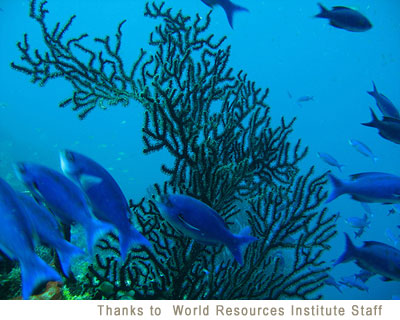Saltwater Aquarium Filtration
The following is a brief description of the various types of filtration commonly used in a marine aquarium.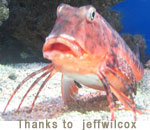
For the large fish-only marine aquarium, we recommend using both a trickle filter and protein skimmer.
A smaller sized fish-only aquarium will do fine with an canister filter.
For a reef aquarium with invertebrates and coral, we recommend a sump tank with mechanical filtration and a protein skimmer - a sump tank is the same as the trickle filter as picture below, with the exception that it does not have the bio-balls or substrate.
The marine aquarium requires clean water and consistent chemical traits, remember you do get what you pay for an it is not advised to try to save money on filtration, or the expensive fish you buy might not live as long as you would like them to!
Below are the brief descriptions of different types of marine filtration to help you be informed before going into your local fish store and making a decision about the type of saltwater fish tank filter you purchase.
Trickle Filter
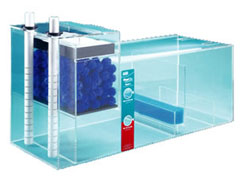 The trickle filter is a must have for a larger fish-only aquarium but is not required for the reef aquarium. The trickle filter's main purpose is to grow huge amounts of beneficial bacteria by oxygenating the water and spraying water over substrate material contained in the filter, bacteria can flourish and grow allowing the biological stability of your aquarium to simulate nature. There are various types of filters, also commonly known as wet dry filters.
The trickle filter is a must have for a larger fish-only aquarium but is not required for the reef aquarium. The trickle filter's main purpose is to grow huge amounts of beneficial bacteria by oxygenating the water and spraying water over substrate material contained in the filter, bacteria can flourish and grow allowing the biological stability of your aquarium to simulate nature. There are various types of filters, also commonly known as wet dry filters.
We have found by experience that the type of filter as pictured on the left is the most effective and easiest to maintain. For more information about this type of saltwater fish tank filter, click here: trickle filter
Protein Skimmer
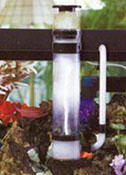
The Protein skimmer is the single most important filter method for a marine aquarium.
Fish naturally excrete organic waste products into the water and the proteins skimmer is the only device of it's kind that eliminates these toxic elements. The protein skimmer is a tall thin column with a motor that pumps the water through and millions of tiny bubbles are forced into the tube. The toxic proteins particles attach themselves to the air bubbles and push up to the surface, collecting in a murky foam substance that is simply discarded. The taller the protein skimmer, the more effective it is since the water travel through more air bubbles. The function is a chemistry reaction between proteins, water and air. Simple yet effective, the protein skimmer is easy to maintain and extremely important for the health and well being of your marine fish. Be sure to ask a lot of questions when investigating a skimmer before you buy. Purchasing a protein skimmer that is too small for you specific needs is very common. protein skimmer manufacturers give recommendations on what range of tank sizes they will accommodate. Always buy a skimmer that if anything is larger than you think you need. Reef aquariums are the most dependant on protein skimmers, so if a manufacturer states their skimmer will do a 100 to 250 gallon tank than it good for 50 to 125 gallons for a reef tank in most cases.
Ozonizers
 Ozoners are an addition to your filtration that improve the function of protein skimmers and they also help to prevent disease in your fish They can be expensive to purchase but it is recommended if your fish are expensive, you want to protect your investment! The way they work is it pumps air over high voltage that converts oxygen into ozone, a highly reactive gas that disinfects the water and kills any bacteria and most parasites floating in the water column. It also adds oxygen to the water, which is always a good thing. It 'injects' ozone into the water as it passes by. You want to inject ozone into the protein skimmer and any air that comes out must be filtered by carbon because it is poisonous to breathe. Also never inject ozone directly into the aquarium because direct contact may harm your fish your fish. Ozonisers must be operated properly or they can cause damage to your lungs, so be sure to read the instructions thoroughly before use.
Ozoners are an addition to your filtration that improve the function of protein skimmers and they also help to prevent disease in your fish They can be expensive to purchase but it is recommended if your fish are expensive, you want to protect your investment! The way they work is it pumps air over high voltage that converts oxygen into ozone, a highly reactive gas that disinfects the water and kills any bacteria and most parasites floating in the water column. It also adds oxygen to the water, which is always a good thing. It 'injects' ozone into the water as it passes by. You want to inject ozone into the protein skimmer and any air that comes out must be filtered by carbon because it is poisonous to breathe. Also never inject ozone directly into the aquarium because direct contact may harm your fish your fish. Ozonisers must be operated properly or they can cause damage to your lungs, so be sure to read the instructions thoroughly before use.Ultraviolet Sterilizers
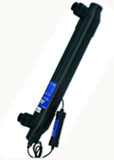 UV sterilizers are important as disease prevention method, especially for invertebrate and corals because if they get disease, medications could kill these delicate creatures instead of curing them. The UV sterilizer is a prevention method that is recommended with every marine aquarium. UV sterilizers do as the name suggests, ultraviolet light sterilizes bacteria and other harmful organisms in the water. UV sterilizers are sold by wattage, it is important to have the proper wattage because too low won't kill any bacteria, too high and it will kill too much bacteria that the fish feed on. Another effect is UV sterilizers can prevent algae blooms. There are various types of UV lamps and their intensity varies, so consult the manufactures recommendations or your favorite tropical fish store for specific advice on the types of bulb and which solution is best for your saltwater fish aquarium.
UV sterilizers are important as disease prevention method, especially for invertebrate and corals because if they get disease, medications could kill these delicate creatures instead of curing them. The UV sterilizer is a prevention method that is recommended with every marine aquarium. UV sterilizers do as the name suggests, ultraviolet light sterilizes bacteria and other harmful organisms in the water. UV sterilizers are sold by wattage, it is important to have the proper wattage because too low won't kill any bacteria, too high and it will kill too much bacteria that the fish feed on. Another effect is UV sterilizers can prevent algae blooms. There are various types of UV lamps and their intensity varies, so consult the manufactures recommendations or your favorite tropical fish store for specific advice on the types of bulb and which solution is best for your saltwater fish aquarium.
Live Rock
As the name suggests, live rock has living bacteria that provides natural biological filtration for your aquarium by contributing to your fish tank's own ecosystem to reduce ammonia and nitrate in your tank. Suitable for both reef tanks and saltwater fish tanks, live rock is an inexpensive and easy form of filtration. Simply pile in your tank and let it do all the work!There are other types of filtration available for the saltwater aquarium, the above are the methods that we recommend and we have used. There is another section about aquarium filtration, geared more towards freshwater fish tanks but the same type of filtration methods could apply. See other aquarium filtration methods for a few more ideas, however we highly recommend the saltwater aquarium filtration methods as, listed above.
For tips on marine aquarium maintenance, click here: How To Maintain your Saltwater Aquarium
